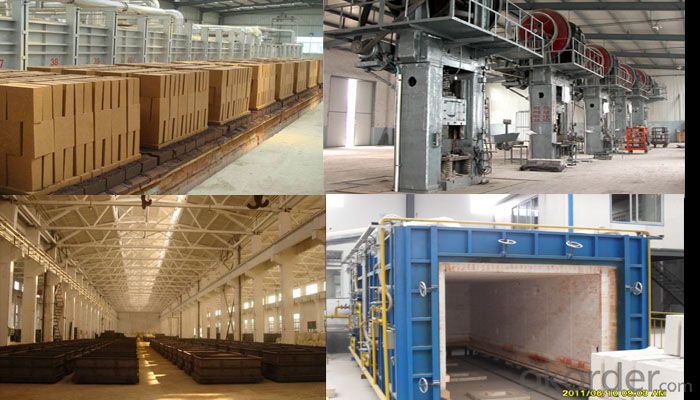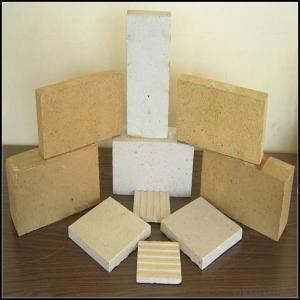High Alumina Insulating Fire Brick for Furnace
- Loading Port:
- China main port
- Payment Terms:
- TT OR LC
- Min Order Qty:
- 1 m.t
- Supply Capability:
- 3000 m.t/month
OKorder Service Pledge
OKorder Financial Service
You Might Also Like
Refractory Brick
CMAX firebricks are classified under temperature between 1300℃ to 1700℃, manufactured from high purity alumina clay.
Refractory bricks the main raw material for aluminum silicate fiber cotton, using vacuum
forming production process, operation and add silica sol, aluminum phosphate inorganic binder,
its role is to ensure that the products of the high temperature strength.

Features
1. High refractoriness.
2. Good spalling resistance and wear resistance.
3. Good corrosion resistance.
4. Good thermal shock resistance.
5. High mechanical strength.
6. High-temperature creep rate is low.
7. Good volume stability at high temperature.
Application
Fire brick is widely used in Blast furnaces, Hot Blast Stove, Steel ladle lining, Reheating furnace, Cement kiln, Tunnel kiln,Boiler, Coke oven, Waste incinerators ,Carbon furnace, Glass kiln , Steel smelting furnace and various kiln lining and thermotechnical equipment, etc.
Data Sheet
Classification Temperature (℉/℃) | 3000/1650 |
Bulk Density (g/cm3 ) | ≤1.0 |
Thermal Conductivity | |
800℃, W/m.K | ≤0.39 |
1000℃, W/m.K | ≤0.43 |
1200℃, W/m.K | ≤0.48 |
Reheating Linear Change (%) | 1550℃×12h |
≤0.9 | |
Chemical Composition (%) | |
Al2O3 | ≥75 |
Fe2O3 | ≤0.5 |
Packaging & Shipping
Packaging Details:Be packed in fumigated wooden pallets
Delivery Detail: 30 days after order

Our Services
Optimum solution and product supply of refractories for high temperature industries, such as iron steel, non-ferrous, petrochemical and building materials.
Engineering design, contract and consult for refractories, and civil architecture design.
Research, development, manufacture and sale of superhard materials.
R&D, manufacture and sale of special packing materials for export.
Inspection, supervision and arbitration of refractories.
Consultation and services in refractories information.
Training and cultivation of high-level talents in refractories profession
Sales Network

Company Information
CNBM (China National Building Material) Group is the largest comprehensive building materials group in China that in integrate scientific research, manufacturing and logistics into one entity. The largest building materials and equipment specialists in China. Upon State Council approval, today CNBM owned more than 300 subordinate manufacturing factories and servicing companies. There are 6 fully owned public listed companies and 11 partially owned with substantial shares public listed companies. In many of these fields, CNBM is playing the leading role in the building industry in the country.


FAQ
1. Which products do you have?
We have all kinds of refractory brick, castable, mortar, cement, ceramic fiber products, etc.
Or you could browse our products to choose what you need.
2. Can you give me a brief introduction of the application of your products?
We are mainly specializing in the refractory materials in iron and steel, cement, glass, ceramics, petrochemical, electric power Industry, etc.
3. If I need your offer, what information do you need?
In order to choose suitable products, it will be appreciated to provide us the information, such us specification, technical data, order quantity, products application etc. If any question, please contact us freely.
- Q: Can insulating fire bricks be used in the construction of refractory-lined vessels?
- Yes, insulating fire bricks can be used in the construction of refractory-lined vessels. Insulating fire bricks have excellent thermal insulation properties and can withstand high temperatures, making them suitable for lining vessels that require heat insulation and refractory properties.
- Q: Are insulating fire bricks suitable for use in the construction of lime kilns?
- Yes, insulating fire bricks are suitable for use in the construction of lime kilns. Insulating fire bricks are specifically designed to have low thermal conductivity, which means they are able to retain heat and prevent heat loss. This is important in lime kilns as they require high temperatures to efficiently convert limestone into lime. By using insulating fire bricks, the heat generated in the kiln can be maintained more effectively, resulting in improved energy efficiency and reduced fuel consumption. Additionally, insulating fire bricks are lightweight and easy to handle, making them ideal for constructing lime kilns. Overall, insulating fire bricks are a reliable and effective choice for the construction of lime kilns.
- Q: Are insulating fire bricks resistant to sound transmission?
- Insulating fire bricks, which are also known as refractory bricks, are primarily designed to withstand high temperatures and provide thermal insulation. Despite their effectiveness in reducing heat transfer, they are not specifically engineered to resist sound transmission. The composition of insulating fire bricks consists of materials like clay, alumina, and silica, carefully selected for their ability to withstand high temperatures. These materials possess density and low porosity, which aids in blocking the passage of heat through the bricks. However, solid materials, including insulating fire bricks, allow sound waves to easily pass through unless additional measures are taken to mitigate sound transmission. To effectively minimize sound transmission, it is advisable to employ other soundproofing techniques in conjunction with insulating fire bricks. These methods may involve incorporating additional layers of acoustic insulation or utilizing sound barriers like mass-loaded vinyl or acoustic panels. In summary, while insulating fire bricks excel in providing thermal insulation, they do not possess inherent resistance to sound transmission. To efficaciously minimize noise transmission within a given area, supplementary soundproofing measures should be implemented.
- Q: Do insulating fire bricks require any special firebrick mortar for installation?
- Yes, insulating fire bricks do require a special firebrick mortar for installation. Regular mortar is not suitable for insulating fire bricks because it may not provide the necessary thermal insulation properties or withstand the high temperatures that these bricks are designed to handle. Insulating firebrick mortar is specifically formulated to withstand extreme temperatures and to bond well with insulating fire bricks. It is typically made from a combination of refractory materials, such as high-alumina cement, silica sand, and fire clay. Using the correct firebrick mortar is crucial to ensure a strong and durable installation of insulating fire bricks.
- Q: Is it possible to paint or coat insulating fire bricks?
- Indeed, it is feasible to apply paint or coat insulating fire bricks. Nevertheless, it is imperative to utilize a type of paint or coating that can endure elevated temperatures, given that insulating fire bricks are intended for usage in exceedingly hot surroundings. Ordinary paint or coatings may not be appropriate since they can combust or deteriorate under high temperatures. It is advisable to employ specialized high temperature paint or coatings that have been specifically formulated to withstand the intense heat of insulating fire bricks. Typically, these types of paint or coatings possess a resistance to high temperatures of several hundred degrees Celsius or greater. Moreover, it is crucial to adequately clean and prepare the surface of the bricks prior to applying any paint or coating to ensure optimal adhesion and durability.
- Q: Can insulating fire bricks be used in high-temperature insulation blankets?
- No, insulating fire bricks cannot be used in high-temperature insulation blankets. Insulating fire bricks are solid and dense bricks made of refractory materials that are designed to provide excellent thermal insulation and structural support in high-temperature applications such as furnaces and kilns. On the other hand, high-temperature insulation blankets are flexible and lightweight blankets made of ceramic fibers or other refractory materials that are specifically designed for insulation purposes. These blankets are able to withstand extremely high temperatures while providing excellent thermal insulation. Therefore, the two products serve different purposes and cannot be used interchangeably.
- Q: Are insulating fire bricks suitable for use in high-temperature chimneys?
- Indeed, high-temperature chimneys can indeed benefit from the utilization of insulating fire bricks. These bricks are purposefully crafted to endure drastic temperatures and offer superb insulation characteristics. With their elevated melting point and reduced thermal conductivity, they possess the ability to proficiently retain heat and obstruct its escape through the chimney walls. Consequently, this aids in maintaining a desirable temperature within the chimney, a pivotal factor for optimal combustion and efficient chimney operation. Furthermore, insulating fire bricks possess the advantageous qualities of being lightweight and long-lasting, rendering them an impeccable selection for constructing chimneys that are subjected to elevated temperatures.
- Q: Are insulating fire bricks resistant to flame spread?
- Insulating fire bricks exhibit exceptional resistance against flame propagation. Crafted with utmost precision, these bricks are tailored to endure extreme temperatures while effectively trapping and insulating heat. Constructed from refractory materials with minimal thermal conductivity, they possess remarkable capabilities in impeding heat transfer and thwarting the spread of flames. Widely employed in kilns, furnaces, and fireplaces, where maintaining and managing high temperatures is of paramount importance, these bricks' flame-resistant properties render them an unwavering and secure choice for such environments.
- Q: What is the thermal expansion of insulating fire bricks?
- Insulating fire bricks undergo changes in dimensions or volume when subjected to temperature variations. These bricks are designed to possess low thermal conductivity and high heat resistance, making them ideal for situations that require insulation and heat containment. Compared to other fire brick varieties, insulating fire bricks exhibit relatively minimal thermal expansion. This is attributed to their composition and manufacturing process, which typically involve lightweight materials like clay, alumina, and silica mixed with organic additives. The low thermal expansion of insulating fire bricks allows them to maintain their shape and structural integrity, even under high temperature conditions. This characteristic is especially crucial in applications that involve thermal cycling, such as furnaces, kilns, and thermal insulation systems. To determine the precise thermal expansion coefficient of a particular brand or type of insulating fire brick, it is necessary to take into account its specific composition and manufacturing process. However, in general, insulating fire bricks possess a lower thermal expansion coefficient compared to conventional fire bricks. This ensures their stability and durability in environments with elevated temperatures.
- Q: How do insulating fire bricks affect the overall energy consumption of a kiln?
- The overall energy consumption of a kiln is greatly influenced by insulating fire bricks. These bricks are crucial in preventing heat transfer due to their low thermal conductivity. By incorporating these bricks into a kiln, the amount of heat lost to the surroundings is significantly reduced, resulting in improved energy efficiency. When the kiln is in operation, it is essential to properly insulate the walls to prevent the high temperatures inside from escaping. Failure to do so would require the kiln to continuously generate additional heat to maintain the desired temperature. However, insulating fire bricks act as a barrier, effectively trapping the heat within the kiln. This means that less energy is needed to achieve and sustain the desired temperatures, resulting in reduced energy consumption. Furthermore, insulating fire bricks also contribute to faster heat-up and cooling cycles. They have a low heat storage capacity, which means they do not absorb and retain heat for prolonged periods. Consequently, the kiln can quickly reach the desired temperature during the heating phase, reducing the time and energy required for optimal kiln operation. Similarly, during the cooling phase, insulating fire bricks aid in dissipating heat more rapidly, allowing for a quicker cooldown and lower overall energy consumption. In conclusion, insulating fire bricks have a significant impact on a kiln's overall energy consumption. By minimizing heat loss, improving energy efficiency, and facilitating faster heating and cooling cycles, these bricks contribute to substantial energy savings and decreased operating costs.
Send your message to us
High Alumina Insulating Fire Brick for Furnace
- Loading Port:
- China main port
- Payment Terms:
- TT OR LC
- Min Order Qty:
- 1 m.t
- Supply Capability:
- 3000 m.t/month
OKorder Service Pledge
OKorder Financial Service
Similar products
Hot products
Hot Searches
Related keywords

































